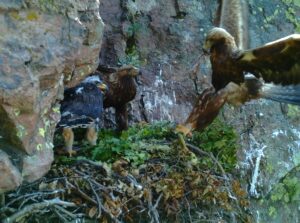Third International Scientific and Practical Conference “Eagles of the Palearctic: Study and Conservation”
Raptors Conservation. Suppl. 2. Proceedings of Conferences
Studying the Nesting Biology of Golden Eagles by Use of Trap Cameras
Angelov I.D. (Bulgarian Society for the Protection of Birds / Birdlife Bulgaria, Plovdiv, Bulgaria)
Contact:
Ivaylo Angelov ivaylo.d.angelov@gmail.com
Recommended citation: Angelov I.D. Studying the Nesting Biology of Golden Eagles by Use of Trap Cameras. – Raptors Conservation. 2023. S2: 20–21. DOI: 10.19074/1814-8654-2023-2-20-21 URL: http://rrrcn.ru/en/archives/34819
Trap camera was installed in an active nest of Golden Eagles (Aquila chrysaetos) in Eastern Rhodopes, Bulgaria. The recordings encompassed 45 days in June and July and the camera took 12 900 photos, from the time when the single nestling was ca. 32 days old until its fledging. 84 food deliveries were recorded, with the prey identified in 76 of them. Land tortoises dominated the diet (65% of the items), followed by Edible Dormouse (Glis glis) (10.5%), snakes (7.9%), and European Hare (Lepus europaeus) (5.2%). The two adults were easily individually identifiable by plumage characteristics,especially on the medium coverts. We recorded unexpectedly high intensity of adding the green material to the nest and cleaning the nest from prey remains, 105 and 35 cases respectively, both done almost exclusively by the female, while the male delivered most of the food – 60 vs 21 of the cases. The female was roosting in the nest with the nestling until when it was 50 days old, after which roosted in the nest only once during a rainy night when nestling was 58 days old. The method provided opportunity for following the lifetime reproductive success of unmarked Golden Eagles.

The male of the Golden Eagle (Aquila chrysaetos) brings to the nest an Edible Dormouse (Glis glis) with partially skinned tail. Photo from camera trap by I. Angelov.
